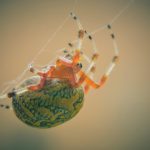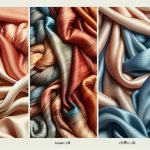When it comes to silk, the three types to note are Mulberry Silk, Spider Silk, and Sea Silk. Mulberry Silk is known for its luxurious sheen and is favored for high-end clothing. Spider Silk is as strong as alloy steel and has great potential for various uses. Sea Silk, sourced from Pinna nobilis, is highly valued for its rarity and delicate harvesting process. Each type brings a unique charm to the world of textiles. There's much more to uncover about the fascinating world of silk types and their diverse applications.
Table of Contents
Key Takeaways
- Mulberry Silk: Known for luxurious sheen and high quality.
- Spider Silk: Lightweight with strength comparable to steel.
- Sea Silk: Rare Mediterranean textile with high value.
- Tussar Silk: Natural golden hue, textured appearance.
- Eri Silk: Boasts exceptional thermal properties, sustainable production.
Mulberry Silk
Mulberry silk, produced by Bombyx mori silkworms feeding on mulberry leaves, dominates the global silk market with its luxurious sheen and high-quality characteristics. It's one of the most widely used types of silk due to its superior quality and durability. Mulberry silk is renowned for its natural sheen, soft texture, and strength, making it a popular choice for various silk products, including Mulberry Silk bedding.
When it comes to different types of silk fabrics, Mulberry silk stands out for its exceptional quality. The production process of Mulberry silk involves careful feeding of silkworms exclusively with mulberry leaves, resulting in silk threads that are smoother, more uniform, and more lustrous compared to other types of silk. The luxurious feel and elegant appearance of Mulberry silk make it a preferred material for high-end clothing, accessories, and home textiles. Its versatility and ability to take on rich, vibrant colors further enhance its appeal in the world of luxury textiles.
Spider Silk
Spider silk is known for its incredible strength, comparable to high-grade alloy steel. However, despite its impressive properties, the production of spider silk on a large scale presents significant challenges.
The strength and potential applications of spider silk make it a valuable material for specialized uses.
Strength of Spider Silk
With a tensile strength comparable to high-grade alloy steel, spider silk exhibits remarkable durability and lightweight properties. It boasts about half the strength of kevlar while weighing only 1/6th as much as steel, showcasing an impressive strength-to-weight ratio.
The extraction and processing of spider silk pose challenges due to its unique properties, limiting large-scale production. However, its exceptional strength and lightweight nature make spider silk highly attractive for various practical applications.
This silk's potential use in advanced materials and technologies has sparked significant interest, highlighting its versatility and promising future in diverse fields requiring strong yet lightweight materials.
Production of Spider Silk
Despite the challenges in large-scale production, the unique properties of spider silk present promising opportunities for specialized applications. When considering the practical applications of spider silk, its tensile strength comparable to high-grade alloy steel stands out.
Additionally, being only half the strength of Kevlar but weighing just 1/6th of steel, spider silk offers a unique combination of strength and lightweight properties. However, the production of spider silk poses significant challenges due to the complexities involved in extracting and processing it in large quantities.
Despite these obstacles, the exceptional strength of spider silk makes it a highly sought-after material for specialized uses in various industries.
Sea Silk
Sea silk, a rare Mediterranean textile, is produced by a specific mollusc known as Pinna nobilis.
This unique silk, also called byssus, holds a significant place in ancient textile tradition.
The harvesting of sea silk involves a delicate process due to its rarity and the threats it faces.
Rare Mediterranean Textile
Occasionally crafted by skilled artisans in Sardinia, the rare Mediterranean textile known as sea silk, or Byssus, boasts a natural chestnut brown hue and is sourced from the bivalve mollusc Pinna nobilis.
Sardinia is one of the few places where this rare textile is still produced.
The dwindling population of Pinna nobilis is endangering the production of sea silk.
Sea silk is highly valued in the textile industry for its scarcity and unique origins.
Due to its limited availability, sea silk commands high prices at auctions.
Byssus From Mollusks
Crafted by skilled artisans in Sardinia, byssus from mollusks, also known as sea silk, is a highly sought-after and exclusive material due to its rarity and unique production process.
Sea silk, extracted from the bivalve mollusc Pinna nobilis native to the Mediterranean region, is naturally chestnut brown and faces extinction from overharvesting. This high-end textile is meticulously harvested and woven by a select few in Sardinia, adding to its exclusivity.
Sea silk threads, delicate and expensive, are auctioned at high prices due to their scarcity. Different from common silks like mulberry and tussar, sea silk offers a luxurious and rare option for textile connoisseurs seeking unique and ethically produced materials.
Ancient Textile Tradition
In the ancient textile tradition of sea silk, artisans in Sardinia meticulously weave threads harvested from the bivalve mollusc Pinna nobilis to create a highly coveted and exclusive material. Sea silk is an extremely rare type of silk originating in the Mediterranean region, known for its delicacy and high cost.
Due to overharvesting, sea silk faces the threat of extinction, making it even more exclusive. The threads of sea silk are naturally chestnut brown, adding to their allure. The labor-intensive process involved in harvesting and weaving sea silk contributes to its reputation as one of the most luxurious types of silk globally.
Tussar Silk
Tussar silk, with its natural golden hue, stands distinct among silk varieties. This type of silk is harvested from silkworms found in wild forests, resulting in a textured appearance that sets it apart from other silks. While Tussar silk's unique color makes it appealing, it is less durable than some other silk varieties and can be harder to dye due to its natural properties. Despite these characteristics, Tussar silk is a popular choice for garments like sarees because of its rustic charm and rough texture, which gives it a distinct look and feel when worn.
| Property | Description |
|---|---|
| Color | Natural golden hue |
| Texture | Textured appearance |
| Durability | Less durable than some silk types |
| Dyeing Ability | Harder to dye compared to other silks |
Eri Silk
Eri silk, derived from the Samia Cynthia caterpillar native to North East India, China, and Japan, boasts exceptional thermal properties ideal for year-round wear and seamless blending with materials like wool and cotton. The luxurious Eri silk is known for its sustainable production methods, making it an eco-friendly choice for those seeking quality and sustainability in their fabrics.
Here are some key points about Eri silk:
- Eri silk has a wool-like feel, providing a unique texture that sets it apart from other types of silk.
- It's commonly used in creating silk-blend items such as curtains and bed covers, adding a touch of elegance and comfort to any space.
- The thermal properties of Eri silk make it a versatile option for various seasons, keeping you cool in the summer and warm in the winter.
- Its production methods focus on ecological sustainability, making Eri silk a conscientious choice for those who value both quality and environmental responsibility.
Muga Silk
Muga silk, originating from the Assam region of India, is renowned for its natural golden hue and exquisite sheen. The silk's distinctive appearance and luxurious feel make it highly coveted in the world of textiles.
From premium traditional Assamese attire to high-end fashion pieces, Muga silk is prized for its lustrous texture and limited availability.
Origin of Muga
Originating from the Assam region of India, Muga silk is produced by silkworms that feed on the leaves of the Som or Soalu plants.
- Muga silk is renowned for its natural golden color and high sheen.
- The production of Muga silk is exclusive to the Assam region.
- This silk is highly valued for its lustrous appearance.
- Muga silk's unique properties make it a sought-after fabric.
Characteristics of Muga
With its distinctive golden hue and exceptional sheen, Muga silk stands out as a prized and luxurious fabric exclusive to the Assam region of India. This premium silk is produced from the Antheraea Assamensis silkworm, which feeds on the leaves of the soalu plant.
Muga silk is renowned for its glossy appearance, lustrous golden color, and high sheen, making it highly valued for its natural golden hue that distinguishes it from other silks. Its limited production adds to its exclusivity, with the Assam region being the sole producer of this exquisite silk.
The unique characteristics of Muga silk make it a symbol of luxury and sophistication, sought after for its premium quality and elegant appeal.
Uses of Muga
Having explored the exceptional qualities of Muga silk, it's fascinating to discover the diverse uses this luxurious fabric serves in various aspects of daily life and cultural expression.
Muga silk, originating from Assam and produced by the Antheraea Assamensis silkworm feeding exclusively on soalu plants, holds a significant place in the fabric world. Its high sheen and natural golden color make it stand out among silk varieties. The premium sarees crafted from Muga silk are highly sought after for their durability and ability to maintain their luster over time.
Apart from its essential uses, Muga silk also plays a crucial role in the cultural heritage of Assam, symbolizing tradition, craftsmanship, and cultural significance.
- Premium sarees made from Muga silk
- Traditional Assamese attire showcasing Muga silk
- Symbol of cultural heritage in Assam
- Craftsmanship and tradition reflected in Muga silk's use
Art Silk
Artificial silk, or art silk, emulates the luxurious properties of real silk using synthetic fibers such as rayon or polyester. This imitation is achieved through industrial processes that carefully replicate the look and feel of natural silk.
Regulations have been implemented to control the use of the term 'silk' for artificial fibers, distinguishing them from genuine silk products. Despite its synthetic nature, art silk serves as a more affordable alternative to authentic silk, making it a popular choice in the textile industry for creating silk-like fabrics and garments.
Its cost-effectiveness and versatility have positioned it as a valuable option for various applications, offering a balance between quality and affordability in the production of luxurious textiles. The development of art silk has provided consumers with a practical solution that meets both their aesthetic preferences and budget constraints in the world of fashion and interior design.
Identifying Artificial Silk
Identifying artificial silk can be challenging due to the striking resemblance that man-made fibers like rayon and polyester bear to authentic silk. When trying to differentiate between artificial silk and real silk, several key factors can help in the identification process:
- Endless Filaments: Artificial silk, such as rayon and polyester, is made up of continuous strands of fibers, unlike natural silk, which is composed of shorter threads.
- Regulations: To combat mislabeling and confusion in the market, regulations have been established to control the use of the term 'silk' for synthetic materials like rayon and polyester.
- Industrial Age Innovations: The industrial age brought about significant advancements in textile production, leading to the creation of artificial silk to mimic the luxurious qualities of natural silk.
- Resemblance to Real Silk: Rayon and polyester are often mistaken for silk due to their similar appearance and feel, making it essential to closely inspect the fabric for subtle differences.
Best Kind of Silk
Mulberry silk stands out as the most popular and widely produced type of silk globally, representing approximately 90% of total silk output. Its fine quality, smooth texture, and durability make it highly sought after in various industries. While other silk types like spider silk, known for its exceptional strength, sea silk, valued for its rarity and unique chestnut brown color, Tussar silk, favored for its textured appearance and natural gold hue, and Eri silk, prized for its thermal properties and wool-like feel, all have their unique characteristics, Mulberry silk is often considered the best kind of silk due to its superior quality and versatility in applications.
When it comes to the highest quality silk production, Mulberry silk consistently ranks at the top for its luxurious feel and excellent dyeing properties. Its popularity and widespread use in luxury bedding, clothing, and accessories showcase its dominance in the silk market. While spider silk, sea silk, Tussar silk, and Eri silk each have their merits, Mulberry silk remains a top choice for those seeking premium silk products.
Silk Products at Gingerlily
Gingerlily presents a range of exquisite silk products, meticulously crafted for elegance and luxury. Their silk bed linen is made from 19 momme mulberry silk, guaranteeing high-quality products that stand the test of time. The durability of Gingerlily's silk products is evident through the careful selection of materials, ensuring long-lasting luxury for your home.
- The use of 19 momme mulberry silk in Gingerlily's products signifies a commitment to exceptional quality and luxury.
- Gingerlily's silk bed linen is designed to provide a smooth and soft sleeping surface, enhancing your comfort throughout the night.
- The hypoallergenic properties of Gingerlily's silk products make them ideal for those with sensitive skin, ensuring a restful night's sleep without irritation.
- Each piece of Gingerlily silk bed linen is crafted with precision and attention to detail, guaranteeing a luxurious experience every time you rest your head.
Grades of Silk Fibre
When considering silk products, understanding the different grades of silk fiber is essential for determining quality and suitability for various uses. Grade A silk represents the highest quality available, characterized by long strands and a pristine pearl white color.
In contrast, Grade B silk yields shorter silk floss with an irregular texture, commonly found in the fashion industry. Grade C silk, located in the innermost layer, possesses a coarse texture, making it a preferred choice for creating silk pillows or as filling for silk duvets.
It's worth noting that silk grades extend beyond A, B, and C to include D, E, F, and unranked categories, which are generally deemed unsuitable for silk bedding or sleepwear due to their inferior quality. The overall silk quality is significantly impacted by factors such as authenticity and the momme weight, which play a vital role in determining the thickness and overall quality of the silk material.
Different Grades of Mulberry Silk
Moving from the discussion of Grades of Silk Fiber, the different grades of Mulberry silk offer varying qualities suited for diverse applications in the textile industry.
- Grade A Mulberry silk is the highest quality, characterized by long strands and a pearl white color, making it a popular choice for luxurious clothing and bedding due to its breathability and lightweight nature.
- Grade B Mulberry silk yields shorter silk floss with an uneven texture, commonly utilized in the fashion industry for various garments.
- Grade C Mulberry silk, found in the innermost layer, possesses a rough texture and is often employed in making silk pillows or filling silk duvets.
- Mulberry silk is categorized into different varieties, with 6A being the top-tier quality available, known for its exceptional properties suitable for high-end textile applications.
Frequently Asked Questions
What Are the 4 Types of Silk?
There are various types of silk, with Mulberry, Eri, Tasar, and Muga being some of them. Each silk kind boasts distinct qualities, from the delicate sheen of Mulberry to the thermal properties of Eri.
What Is Highest Quality Silk?
When it comes to silk quality, Grade A is considered the highest. With its long strands and pearl white color, Grade A silk is breathable, smooth, and lightweight. It's the top choice for luxurious products.
What Are the Three Examples of Silk?
Sure, Mulberry silk, Eri silk, and Tussar silk are three examples. Each type has distinct qualities. Mulberry silk shines delicately, Eri silk feels like wool, and Tussar silk has a textured look and gold color.
What Is the 3 Grade of Silk?
When it comes to the 3 grade of silk, it's important to understand the distinctions between Grade A, B, and C. Grade A boasts top quality, Grade B is shorter with an uneven texture, and Grade C is rougher and ideal for pillows or duvets.
- What Is Pochampally Ikat? a Journey to India’s Silk City - June 27, 2025
- What Is Pochampally Ikat? a Journey to India’s Silk City - June 27, 2025
- What Is Pochampally Ikat? a Journey to India’s Silk City - June 27, 2025







